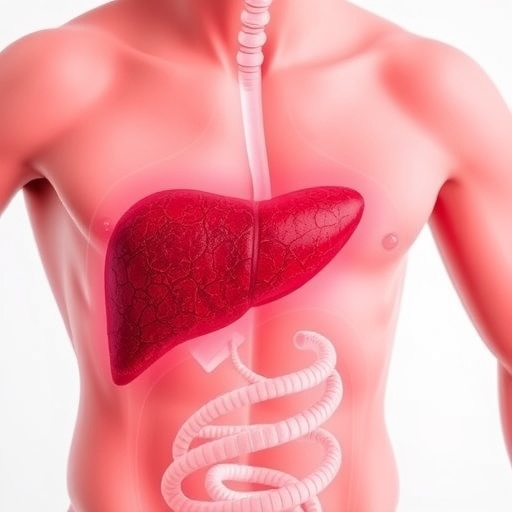Basal Metabolic Rate Emerges as a Key Driver in Liver Cancer Development and Progression
In a groundbreaking study poised to reshape our understanding of cancer metabolism, researchers have unveiled how basal metabolic rate (BMR) fundamentally influences the development and progression of hepatocellular carcinoma (HCC), a primary form of liver cancer. This compelling investigation reveals that intrinsic metabolic variations at the cellular level, manifesting as differences in BMR, can create a biological landscape more conducive to tumorigenesis, with profound implications for cancer diagnosis, prognosis, and potential therapeutic avenues.
Basal metabolic rate, accounting for up to 70% of total human energy expenditure, reflects the energy needed for maintaining vital physiological functions at rest. Traditionally considered a systemic indicator of energy consumption, BMR is now being recognized for its nuanced relationship with cellular processes underpinning tissue growth and cancer susceptibility. By examining animal models genetically selected for divergent BMR levels, the study provides novel insights into how intrinsic metabolic profiles influence cancer dynamics.
.adsslot_ZYeCL5WdSN{ width:728px !important; height:90px !important; }
@media (max-width:1199px) { .adsslot_ZYeCL5WdSN{ width:468px !important; height:60px !important; } }
@media (max-width:767px) { .adsslot_ZYeCL5WdSN{ width:320px !important; height:50px !important; } }
ADVERTISEMENT
Analysis unveiled a dramatic disparity in cancer incidence and progression between the two mouse populations. Mice with high BMR (HBMR) developed liver tumors at a significantly accelerated pace compared to their low BMR counterparts. This rapid tumorigenesis was accompanied by pronounced hepatomegaly—a marked increase in liver size—driven predominantly by hepatocyte enlargement rather than just cell proliferation, signaling a fundamental alteration in cellular metabolism and growth patterns.
At the molecular level, HBMR mice displayed elevated expression of key oncogenic and metabolic regulators, including mechanistic target of rapamycin (mTOR), phosphoinositide 3-kinase (PI3K), and the proto-oncogene c-myc. These genes orchestrate crucial cellular processes such as growth, proliferation, and metabolic reprogramming, further implicating metabolic rate as a critical modulator of oncogenic signaling pathways. Notably, insulin-like growth factor 1 (IGF-1), often linked with tumorigenesis, did not exhibit significant changes, suggesting that alternative metabolic pathways predominantly mediate these effects.
Concurrently, the study revealed a concomitant suppression of tumor-suppressor activity in HBMR mice, with decreased functional expression of p53 and adenomatous polyposis coli (APC) proteins. The diminished activity of these gatekeeper proteins facilitates unchecked cellular growth and tumor expansion, reinforcing the link between elevated metabolic demands and genomic instability or compromised anti-cancer defenses.
These observations illustrate a complex interplay whereby genetically determined high BMR predisposes liver cells to metabolic stress, triggering oncogenic pathways and impairing tumor suppressor functions. This metabolic burden may accelerate neoplastic transformation and tumor progression, framing BMR not just as a passive reflection of physiological status but as an active participant in cancer biology.
Understanding the metabolic underpinnings of HCC is particularly critical given the global burden of liver cancer, which remains one of the leading causes of cancer-related mortality. Traditional risk factors such as hepatitis infections, alcohol use, and metabolic disorders do not fully account for individual variability in cancer susceptibility and progression rates. This study’s findings introduce BMR as an intrinsic and potentially predictive factor worth integrating into risk stratification models.
The implications extend beyond diagnostic paradigms; targeting metabolic regulators altered in high-BMR states could inform novel therapeutic strategies. For instance, inhibitors of mTOR and PI3K pathways have already shown promise in oncology, and their efficacy might be particularly pronounced in patients characterized by elevated basal metabolic activity. Likewise, restoring tumor suppressor functions or mitigating metabolic stress could constitute complementary clinical approaches.
Moreover, this research invites a broader reevaluation of cancer metabolism, emphasizing cell size and organ-specific energy demands in carcinogenesis. As BMR correlates with the mass of metabolically active organs, the expansion of these tissues, and changes in their cellular architecture, underpin a microenvironment conducive to malignant transformation. Such perspectives may generalize across other cancers where metabolism is dysregulated.
The study also highlights the importance of genetically based metabolic traits in shaping cancer risk and progression. This genetic-metabolic framework challenges the prevailing focus on external carcinogens and lifestyle factors, suggesting that inherent metabolic programming must be considered in comprehensive oncological assessments.
Future research directions might involve exploring how modulating metabolic rates through pharmacological or lifestyle interventions impacts cancer development, potentially opening avenues for prevention. Understanding how metabolism interfaces with the immune response in tumor microenvironments could further elucidate mechanisms by which BMR influences cancer dynamics.
The insights garnered from this investigation underscore a paradigm shift—basal metabolic rate is more than an energetic statistic; it is a biological determinant with the capacity to shape the course of cancer in profound ways. By uncovering the genetic and molecular substrates linking BMR to hepatocellular carcinoma, this work lays the foundation for innovative diagnostic biomarkers and tailored therapeutic approaches designed to combat malignancies rooted in metabolic dysfunction.
As the interplay between metabolism and cancer continues to unfold, this study stands as a testament to the power of integrating physiological, genetic, and molecular analyses to unravel the intricacies of neoplasm biology. Clinicians and researchers alike will benefit from these revelations, which promise to enhance precision medicine approaches and improve outcomes for patients grappling with liver cancer globally.
Subject of Research: The influence of basal metabolic rate on the development and progression of hepatocellular carcinoma.
Article Title: Basal metabolic rate shapes the development and progression of hepatocellular carcinoma.
Article References:
Maciak, S., Sawicka, D., Kasacka, I. et al. Basal metabolic rate shapes the development and progression of hepatocellular carcinoma. BMC Cancer 25, 1102 (2025). https://doi.org/10.1186/s12885-025-14491-4
Image Credits: Scienmag.com
DOI: https://doi.org/10.1186/s12885-025-14491-4
Tags: animal models in cancer studiesBasal metabolic rate and liver cancerBMR impact on physiological functionscancer diagnosis and prognosis implicationscancer metabolism researchenergy consumption and cancer dynamicsenergy expenditure in cancer developmenthepatocellular carcinoma progressionintrinsic metabolic profiles and cancer susceptibilitymetabolic profiles and organ sizemetabolic variations and tumorigenesistherapeutic avenues in liver cancer





